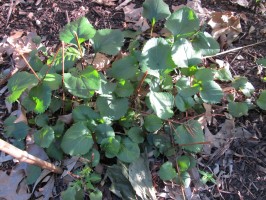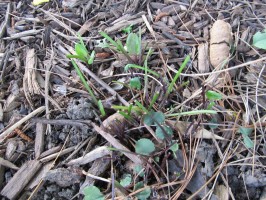By Ed Schmidt
Squaw weed, also known as round-leaved ragwort, has beautiful yellow flowers in the spring, and the leaves make an attractive ground cover. It thrives in shade, and tolerates fairly dry conditions. On the Missouri Botanical Garden’s Plantfinder, it gets 4 stars. Originally designated as Senecio obovatus, the current scientific name is Packera obovata.
At our June meeting, Dave Tylka described how squaw weed was popping up in places where he didn’t want it. He noted that the dandelion-like airborne seeds were the source of the problem, and he recommended not planting it. At least one Wild Ones member was inspired to remove her plants the following day.
The squaw weed in my yard is well-behaved, and doesn’t seem to spread by seed. It spreads by stolons (runners), but more slowly than wild ginger. Rabbits seem to like it, and their frequent nibbling keeps it from spreading as fast as I’d like.
To see squaw weed in bloom, see this post by Betty Hall in Kentucky.
Do you have squaw weed in your yard? What is your experience with it?
Editor’s note: See Dave Tylka’s response in the comments below.




I love senecio and have not found it too be invasive. I am a natural look gardener and appreciate its surprising beauty
I find it spreads easily. I think only from runner roots. It pulls out easily too if it is somewhere you do not like. It fills in spaces easily and quickly. I have put it at the base of a rock wall where something short should grow. When I mow the yard I can mow down any outward growth I do not want.
If it spreads by seed I should have it growing in the bed above this foot high wall. I do not.
You can pull it up with roots attached, push it into the ground somewhere else and it seems to survive without pampering.
I like it.
Thanks Ed for this conversation. I heard Dave say that too and wondered about it.
There is more than one kind of senecio/squaw weed. He may have something different than I have.
Kathy Bildner
My experience is similar to Kathy’s. I believe mine is Senecio aureus which is called Golden Ragwort in the Missouri Wildflower Nursery catalog. It looks similar to Ed’s photos. It thrives in a very wet area where I couldn’t get anything else to grow, forms a dense carpet by spreading roots, and stops when it reaches a certain height on the hillside where it is slightly drier. Again, no apparent spreading by seed.
Eisendrath’s “Missouri Wildflowers of the St. Louis area” states obovatus has “Basal leaves with winged petioles…” while aureus has “Basal leaves long petioled…”
Perhaps Dave, you have Senecio obovatus. Could you post a photo?
Just got home from an out-of-town trip, thus my “timely” response. At the June WO meeting at our home, I believe that I said squaw-weed (Packera [Senecio] obovatus) is mildly aggressive and needs to be managed by clipping off the flowers as they start forming seed heads like dandelions and by pulling out the peripheral plants that come up from the spreading underground roots or rhizomes. Although it readily spreads underground as many of you have reported, at other locations in our backyard, disjunct new patches have grown up about 15 feet downhill from parent patches, thus my assumption that they also spread from seed. Perhaps the seeds need to land where there is a little bare soil to get a start.
I believe that I also mentioned that this spreading ability can be a good characteristic if you want a large ground cover and cited the downtown Kirkwood church (about 2 blocks from the railroad tracks on Lindbergh) as an example of this. When their landscape budget was cut, the church personnel took advantage of this plant’s aggressiveness because it gave them a nearly weed-free, short evergreen ground cover that required/requires little maintenance.
In our landscape, this hearty evergreen plant grows in shade or sun and dry or moist (not wet) conditions. The larger-leaved cousin (aureus) likes moist to wet conditions as Betty has pointed out. I also said that when flowering, it is a fairly good pollinator source for smaller insects–small bees and flies and a few beetles and is frequented by uniquely-shaped scorpion flies. Although squaw-weed may require more maintenance than other natives, every native plant has its place and function.